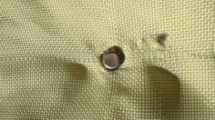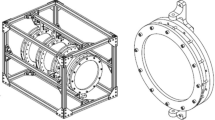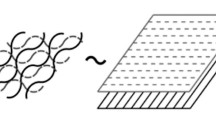Abstract
The motion, deformation, and destruction of a thin fiber under the action of a transverse shock load are numerically simulated. The fiber is described by the equations of Rakhmatulin’s theory. The system of dynamic equations is solved using the finite-difference method. The parameters for the model can be obtained directly from impact loading experiments, so the dependence of the material properties on the strain rate can be taken into account. Numerical results for aramid fibers under impact load are presented. Loading modes with and without fiber breakage are considered. A direct comparison of the numerical and experimental data is presented. A good agreement between them is demonstrated. The resulting validated numerical model of a single fiber can further be used to describe a fabric material as a system of interacting fibers.
Similar content being viewed by others
Avoid common mistakes on your manuscript.
INTRODUCTION
Flexible protective fabric screens are widely used in numerous engineering areas, including the space industry, where they are regular components ensuring safety of piloted stations. The traditional shielding structure still relies on the original ideas of Whipple [1] and consists of three layers. The first layer is made of metal and ensures splitting of micrometeorites and space debris, turning a high-speed large particle with a concentrated impact into a cloud of fine splinters distributed in time and space. The second intermediate layer is made of a fabric material. It absorbs some of the impact energy, thus additionally reducing the thermal and impact load. The third layer is the protected wall, which is supposed to escape destruction.
The optimization of the fabric component of a protective screen is an important task for the general enhancement of the safety of piloted spacecraft. Additionally, interest in fabric screens has recently been motivated by the idea of using transformed modules with flexible walls as part of large spacecraft. Methods for protecting flexible modules from impacts of micrometeorites and space debris are an open engineering problem [2]. For flexible modules, the use of traditional structure of protective screens with a rigid first wall is unrealistic, so new ideas are actively sought [3].
Fast estimates of a transverse impact on fabric constructions are traditionally derived using the theory of transverse impact on a thin fiber based on Rakhmatulin’s studies [4–6] and Smith’s works [7, 8]. According to this theory, the fiber is assumed to be thin and experiences only a tensile force, while the processes in the fiber cross section are ignored. A transverse impact on such a fiber gives rise to longitudinal and transverse waves propagating through it. Under this load, the fiber takes a typical V-shape, which is shown in Fig. 1. This shape persists until the waves reflect from the fiber’s restraint points or until the destruction of the fiber.
In the classical theory, there are important relations (1)–(3), which are widely used in engineering practice [9]. They relate the longitudinal wave velocity Cp, the transverse wave velocity Cs, the impactor velocity V, and the deformation ε in the fiber behind a longitudinal wave:
These simple relations are valid only if the fiber is initially undeformed, the condition \({{C}_{s}} \ll {{C}_{p}}\) holds over the whole process, the fiber can be treated as infinitely long, and the impactor velocity is constant. Nevertheless, these constraints are satisfied for a large number of practically important settings.
It should be noted that the simple relations of the classical theory fail to describe some effects observed in practice. For example, according to some works, the differences between experimental data and estimates based on the above formulas can reach 40% [10]. This motivates the development of models taking into account various factors, such as the microstructure of fibers [11, 12]. Note also that many observed effects can be explained within the classical theory when the original system of fiber dynamics equations is solved for a particular case, instead of using the standard relations (1)–(3). This approach is used, for example, in [13, 14]. We also stay within Rakhmatulin’s classical theory, but the original system of equations is solved numerically.
MATHEMATICAL MODEL AND NUMERICAL METHOD
We use the original system of equations from [4–6]. The motion of the fiber is described by the equations
For an impact of constant velocity, the system of equations becomes [4]
The following notation is used in Eqs. (4) and (5): \({{\rho }_{0}}\) is the density of the fiber material, which is assumed to be constant; \(T\) is the fiber tension; P is the external transverse load applied to the fiber; \(\varepsilon \) is the deformation of the fiber; \({{s}_{0}}\) is the distance along the fiber; (x; y) are spatial coordinates; and \(\varphi \) is the angle between the tangent to the fiber and the OX axis. The introduced coordinate system is shown in Fig. 2. The fiber segment and its tangent are shown by the solid and dotted lines, respectively.
The impact speed is assumed to be constant, because we consider a massive impactor whose deceleration over the time of interaction with a single fiber can be neglected. The governing system is solved numerically by applying the second-order finite-difference scheme described in [15].
Separately, we discuss how to specify the parameters of the given model. To describe the fiber, we need its density, Young modulus, and ultimate tensile strength. The density is easy to specify, in contrast to the elastic and strength parameters. For materials, parameters are traditionally inferred from static tests. However, static parameter values can differ widely from dynamic ones, which are exhibited under impact loading. For example, according to the data from [16], Young’s modulus and the ultimate tensile strength of Kevlar 49 vary by more than 30% in a relatively short range of strain rates.
In the range of speeds of interest, Young’s modulus can be estimated using relation (1). At the initial stage of the impact, it holds with good accuracy, so given the transverse wave velocity observed in experiments and the impactor speed, we can obtain the longitudinal velocity of sound in the material, which is then used to determine the dynamic Young modulus. It should be noted that high-accurate values are difficult to obtain in this way, since Young’s modulus has a small exponent in the relation. Nevertheless, an estimate can thus be obtained. The ultimate tensile strength can be found by solving the coefficient inverse problem in the case of a sufficient amount of experimental data.
RESULTS AND DISCUSSION
To validate the model and the method, we used the experimental data from [17] concerning impact load on aramid fibers in the speed range of 200–510 m/s. The data involve loading modes of fiber destruction and deformation without breakage.
The fiber density is 1440 kg/m3. According to the experimental data, the dynamic Young modulus can be estimated as 80 GPa. For the ultimate elongation in destruction, we used a value of 5%.
For validation, we used experiments with impact speeds of 197 and 497 m/s, for which detailed time patterns of the fiber shape under deformation and destruction are available. Figures 3 and 4 show the numerical results and their comparison with the experiments.
Comparison of the numerical results and experiments; the impact speed is 197 m/s. The plots in the panels are given at time intervals of 10 µs. The axes represent the spatial coordinates in millimeters. The computed fiber shape is shown in black, and the approximation of the fiber segment as taken by a camera is depicted in gray. The impactor edge touches the fiber at the point (0; –10). The impactor moves left.
Comparison of the numerical results and experiments; the impact speed is 497 m/s. The plots in the panels are given at time intervals of 10 µs. The axes represent the spatial coordinates in mm. The computed fiber shape is shown in black, and the approximation of the fiber segment as taken by a camera is depicted in gray. The impactor edge touches the fiber at the point (0; –10). The impactor moves left.
Figure 3 presents the results for an impact of speed 197 m/s. The initial experimental data with a frame-by-frame representation of high-speed photography can be found in [17], where was used pointwise specified approximation of a fiber segment with a fixed camera. In Fig. 3, this segment is depicted by the gray line. In the same panels, the fiber shape obtained numerically at the same time is shown in black. In this regime, fiber destruction was not observed.
It can be seen that the fiber shapes agree well, which suggests the adequacy of the used model and method. Note that, at the initial time, the fiber in the experiment is not perfectly vertical, which differs from the formulation of the computation. However, this fact does not affect the basic deformation process, in which the experimental and computed fiber shapes coincide.
It should also be noted that, in the experiment, the fiber exhibits a noticeable forward rebound from the impactor, which can be seen as a deviation of the fiber shape from the vertical in the central part of the impactor (about zero on the OY axis). This well-known effect was described in [10]. It is expected in some deformation regimes and is associated with processes over the fiber thickness that are ignored in our model. However, they do not affect the motion of the basic part of the fiber.
Figure 4 shows the results for an impact of speed 497 m/s, in which case the fiber breaks. The general contour of the destroyed fiber according to the experiment is shown in gray; it is the envelope of all its fragments. This is associated with the fact that, due to its resolution, the camera failed to record the point and moment of breakage [17].
It can be seen that the numerical results agree well with the experimental data over the first 40 µs of the process, but a visually noticeable difference in the shape of the fiber fragments is observed at the final stage. This is explained by the mathematical ideality with which the fiber ends are restrained in the computation. As a result, the unloading wave generated in fiber breakage reflects from the restraint points. In the experiment, the boundary conditions are not ideal, and the fiber shape gets smoothed by the slip at the restraint points. Overall, the computed positions of the fiber and its fragments after breakage are described adequately.
CONCLUSIONS
A transverse impact on aramid fibers in the speed range of 200–510 m/s was numerically simulated. The numerical results were directly compared with experimental data in loading modes with and without fiber breakage. In the experiments and computations, the shape of the deformed fiber (transverse wave velocity) and the description of the fiber breakage at an impact speed of 500 m/s were found to agree well. Thus, the mathematical model of a fiber has been validated against the experimental results in the given speed range.
This model of a single fiber can further be used to develop a model of a flexible protective fabric screen consisting of discrete fibers. An additional study will be required for the interlayer interaction of screen elements and impact-wave processes proceeding over the thickness of multilayered fabric packets.
Change history
27 September 2022
An Erratum to this paper has been published: https://doi.org/10.1134/S1064562422050027
REFERENCES
F. L. Whipple, “Meteorites and space travel,” Astron. J. 52, 131 (1947).
E. P. Buslov, I. S. Komarov, V. V. Selivanov, V. A. Titov, N. A. Tovarnova, and V. A. Feldstein, “Protection of inflatable modules of orbital stations against impacts of particles of space debris,” Acta Astronaut. 163, 54–61 (2019).
Y. H. Kim, C. H. Choi, S. K. S. Kumar, and C. G. Kim, “Behavior of dragon skin flexible metal bumper under hypervelocity impact,” Int. J. Impact Eng. 125, 13–26 (2019).
H. A. Rakhmatulin, “Oblique shock with a great velocity on a flexible string in presence of friction,” Prikl. Mat. Mekh. 9 (6), 449–462 (1945).
H. A. Rakhmatulin, “On the shock of a flexible string,” Prikl. Mat. Mekh. 11 (3), 379–382 (1947).
H. A. Rakhmatulin, “Transverse shock of a flexible string by a body of a given shape,” Prikl. Mat. Mekh. 16 (1), 23–34 (1952).
J. C. Smith, F. L. McCrackin, and H. F. Schiefer, “Stress-strain relationships in yarns subjected to rapid impact loading. Part V: Wave propagation in long textile yarns impacted transversely,” Textile Res. J. 28 (4), 288–302 (1958).
J. C. Smith, J. M. Blandford, and H. F. Schiefer, “Stress-strain relationships in yarns subjected to rapid impact loading. Part VI: Velocities of strain waves resulting from impact,” Textile Res. J. 30 (10), 752–760 (1960).
S. Sockalingam, S. C. Chowdhury, J. W. Gillespie, Jr., and M. Keefe, “Recent advances in modeling and experiments of Kevlar ballistic fibrils, fibers, yarns and flexible woven textile fabrics: A review,” Textile Res. J. 87 (8), 984–1010 (2017).
J. D. Walker and S. Chocron, “Why impacted yarns break at lower speed than classical theory predicts,” J. Appl. Mech. 78 (5), 051021–0510214 (2011).
S. L. Bazhenov, I. A. Dukhovskii, P. I. Kovalev, and A. N. Rozhkov, “The fracture of SVM Aramide fibers upon a high-velocity transverse impact,” Polymer Sci. Ser. A 43 (1), 61–71 (2001).
B. Song and W. Y. Lu, “Effect of twist on transverse impact response of ballistic fiber yarns,” Int. J. Impact Eng. 85, 1–4 (2015).
S. Chocron, T. Kirchdoerfer, N. King, and C. J. Freitas, “Modeling of fabric impact with high speed imaging and nickel-chromium wires validation,” J. Appl. Mech. 78 (5), 051007–051001 (2011).
J. E. Field and Q. Sun, “A high speed photographic study of impact on fibers and woven fabrics,” SPIE Proceedings: 19th International Congress on High-Speed Photography and Photonics (1991), Vol. 1358, pp. 703–712.
A. V. Vasyukov, M. A. Elovenkova, and I. B. Petrov, “Modeling a thin fiber deformation and destruction under a dynamic load,” Math. Models Comput. Simul. 13 (1), 60–65 (2021).
D. Zhu, B. Mobasher, and S. D. Rajan, “Dynamic tensile testing of Kevlar 49 fabrics,” J. Mater. Civil Eng. 23 (3), 230–239 (2011).
L. B. Vasilchenko, E. S. Onuchin, D. A. Orlov, and N. A. Tovarnova, “Experimental study of fabric dynamics under impact,” Kosmonavtika Raketostroenie 123 (6), 58–63 (2021).
Funding
This work was supported by the Russian Foundation for Basic Research, project no. 18-29-17027.
Author information
Authors and Affiliations
Corresponding authors
Ethics declarations
The authors declare that they have no conflicts of interest.
Additional information
Translated by I. Ruzanova
The original online version of this article was revised: Due to a retrospective Open Access order.
Rights and permissions
Open Access. This article is licensed under a Creative Commons Attribution 4.0 International License, which permits use, sharing, adaptation, distribution and reproduction in any medium or format, as long as you give appropriate credit to the original author(s) and the source, provide a link to the Creative Commons license, and indicate if changes were made. The images or other third party material in this article are included in the article’s Creative Commons license, unless indicated otherwise in a credit line to the material. If material is not included in the article’s Creative Commons license and your intended use is not permitted by statutory regulation or exceeds the permitted use, you will need to obtain permission directly from the copyright holder. To view a copy of this license, visit http://creativecommons.org/licenses/by/4.0/.
About this article
Cite this article
Petrov, I.B., Vasyukov, A.V., Beklemysheva, K.A. et al. On Numerical Modeling of Fiber Deformation and Destruction under Impact Load. Dokl. Math. 105, 207–211 (2022). https://doi.org/10.1134/S1064562422030061
Received:
Revised:
Accepted:
Published:
Issue Date:
DOI: https://doi.org/10.1134/S1064562422030061








